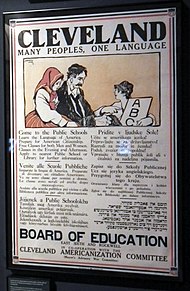
The demographics of Cleveland have fluctuated throughout the city's history. From its founding in 1796, Cleveland's population grew to 261,353 by 1890, and to 796,841 by 1920, making it the fifth largest city in the United States at the time. By 1930, the population rose to 900,429 and, after World War II, it reached 914,808.[1] Due to various historical factors including deindustrialization, suburbanization, and urban sprawl, Cleveland's population began decreasing in the 1960s. By 1970, the city's population was 750,903. By 1980, it was 573,822 and it had lost its position as one of the top 10 largest cities in the U.S.[1] By 2020, the population had further fallen to 372,624.[2] Beginning in 2018, the city's population began to flatten, after decades of decline.[3] Additionally, between 2010 and 2020, several neighborhoods within Cleveland saw a significant population increase, most notably Downtown,[4] but also University Circle and several West Side neighborhoods.[5]
- ^ a b Gibson, Campbell (June 1998). "Population of the 100 Largest Cities and Other Urban Places in the United States: 1790 to 1990". U.S. Census Bureau. Retrieved October 20, 2012.
- ^ "U.S. Census Bureau Quick Facts: Cleveland". Retrieved May 21, 2020.
- ^ Exner, Rich (May 23, 2019). "Cleveland's population flattens near 385,000 after decades of big losses, new census estimates say". The Plain Dealer. Retrieved July 3, 2019.
- ^ Exner, Rich (May 13, 2016). "How downtown Cleveland is changing: by the numbers". The Plain Dealer. Retrieved July 3, 2019.
- ^ "Census 2020 in Cleveland". Cleveland City Planning Commission. Retrieved July 11, 2022.
